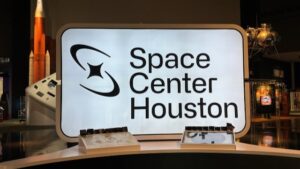
Four years ago, my wife and I went to the Kennedy Space Center at Cape Canaveral, Florida. Having grown up with the space race, it was a place I’d wanted to visit my entire life, and it did not disappoint (I wrote about that adventure here). Afterwards, I vowed that I would someday visit NASA’s headquarters at its sister facility, the Johnson Space Center in Houston, Texas. Unfortunately, COVID got in the way, so I wasn’t able to make the trip until last week.
Since it has no launch pads, the JSC isn’t as impressive as the KSC. But it is where astronauts have trained for six decades and there was lots to see on the tours I took.
In one of the buildings, we saw the original mission control room from the Apollo era, complete with a demonstration of what it looked like on July 20, 1969, as men first set foot on the moon. The presentation was narrated by former flight director Gene Kranz (Ed Harris played him in “Apollo 13”), who I had the honor of interviewing in 2000 (you can listen to that conversation here). It’s still remarkable to know that the smartphones we carry in our pockets each have more computing capabilities than all the NASA computers in the room combined.
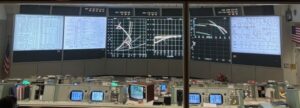
Right next door, we saw the current mission control, full of people monitoring the International Space Station — just some of the many NASA employees we saw throughout the JSC. It is, after all, a working government operation.
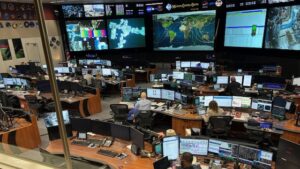
Another highlight was seeing the Neutral Buoyancy Laboratory, the giant pool (202′ long, 102′ long, 40′ deep) where astronauts train for spacewalks on the exterior of the ISS. The pool is so big that the entire space station fits inside, and the water is perfectly clear because it’s fully filtered every nineteen hours. When the astronauts are going to work in there, they wear their full spacesuits, which can take two hours to put on. Then, because they can’t swim in the suits, a crane picks them up and places them in the water, where a team of safety divers (five per astronaut) move them to the area they’ll practice in. It’s really something to see.
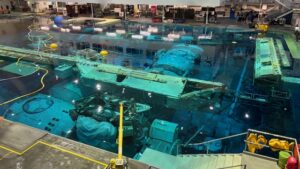
As for those spacesuits, each one costs close to twenty million dollars because it contains so many layers of protective fabric including kevlar, tubing filled with water to keep the wearer cool, a system to provide oxygen and remove carbon dioxide, plus gloves and boots designed expressly for working in space. Oh, and because spacewalks often take 5-7 hours, the astronaut wears a MAG or maximum absorbency garment — what we call an adult diaper.
The land the JSC sits on (some 1,600 acres) was sold to NASA by Rice University for $20 and a guarantee that all the facilities would be made of concrete and look like they belonged on an early 1960s college campus. Why so little? Because the federal government couldn’t just accept a donation — it had to have a price. But why the contingency? Because at the formation of NASA, Rice’s administrators were sure the agency would fail at putting humans in space and would thus close, leaving Rice with all those buildings built at taxpayer cost. Yep, bad call, Rice.
Another building we visited was named after Jake Garn, who went through astronaut training while serving in the US Senate, where he chaired the committee that determined NASA’s budget. He then served as a payload specialist aboard a space shuttle — where he was severely nauseated for the entire week. In fact, he was so sick to his stomach that future astronauts’ capacity for being in microgravity was compared on the Garn Sickness Scale — a Quarter Garn, a Half Garn, all the way up to the Full Garn. That was later replaced by a scale of one to ten, but his name was still invoked as the standard. Quite a legacy.
In yet another facility, there’s another mockup of the ISS, including the exit hatch that points downward, so astronauts sometimes have to swallow twice before stepping through, knowing there’s nothing between them and the Earth below but a vast 250 miles of nothing. Of course, they can’t fall, but even the heartiest of astronauts have been known to pause for a second or two.
That same building contains an exceedingly cramped Soyuz capsule that cosmonauts still use to get to and from the ISS. It’s such a tight fit because when the Russians started carrying three passengers instead of two, they didn’t make it bigger, they just crammed the humans in the same space.
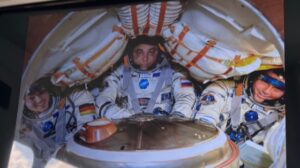
American space vehicles have pretty small interiors, too, which served as a reminder that despite my boyhood dreams, I could never have become an astronaut because I grew past six feet in high school and was thus too tall for the space program where candidates must be between 5’2″ and 6′. In fact, I was too big for part of the tour, a space shuttle mockup I couldn’t even climb through to get to its cockpit, where my claustrophobia would have rendered me inert.
Also in that huge building are rovers that will be used on the lunar surface during the Artemis mission, and a simulator for the Starliner, a reusable capsule that might be used for that flight. However, it’s a Boeing project that was supposed to be ready in 2017, but ran into delays and cost overruns that have kept it from being completed. Considering Boeing’s recent troubles with 737s and other planes, I’m not so sure I’d want to get on board that spacecraft — or be confident the doors wouldn’t fall off.
There were myriad other stories I’d never heard before, but to save some space (!), I’ll just give you links to read about them:
- the astronaut who almost drowned in space;
- how shuttle crews used a Snoopy doll to know when they’d made it to space;
- the Valkyrie robot (which looks like Iron Man) being developed to eventually build new habitats on the moon and Mars.
My final stop at Space Center Houston was a theater showing this wonderful short film, “Down To Earth,” in which astronauts describe their awe at looking at our planet through the ISS windows, seeing the thin blue line of our atmosphere, weather phenomena like hurricanes and sand storms, and — most of all — a world with no geopolitical borders.
